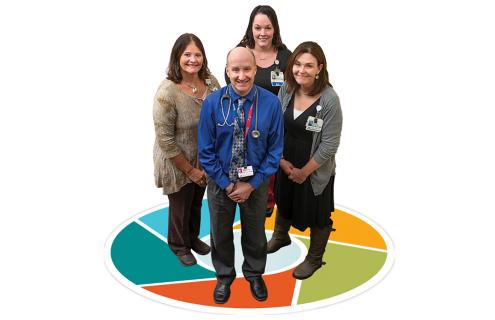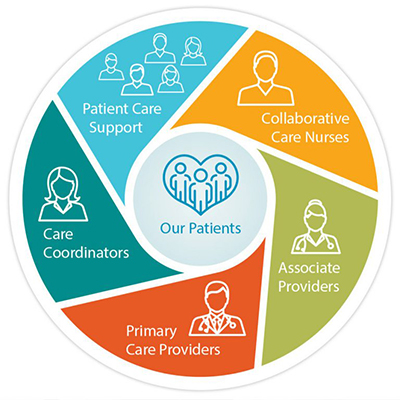
Dr. Andy Tremblay and Nurse Practitioner, Currier Neily, APRN share an office in Family Medicine at Cheshire Medical Center. It’s a small one, 12ʹ x 12ʹ, where their desks are kitty-cornered, with a large whiteboard overhead, keeping an eye on projects. Daily conversations are not only impossible to avoid, but welcome. And, the thing is, it’s all by design.
Tremblay and Neily are two of the more than a dozen members of Team D in Family Medicine, and they work together under a style of collaboration called the Medical Home Team (MHT) model. It’s a standard devised with the patient at the center of a collaborative approach that ensures continuity of care from a group of professionals, who share information and workload in a way that’s most efficient for those under their care. All four teams at the medical center on Court Street, as well as Cheshire’s family medicine practices in Walpole and Winchester, strive to take this approach.
For example, on Team D, Tremblay and Neily are supported by physician assistants, nurse collaborative care coordinators, RN care coordinators, results management nurses, medication renewal managers, team phone nurses, behavioral health consultants, forms managers, patient flow staff, call center receptionists, and registry coordinators, who are proactive in reaching out to patients to make sure they are up-to-date on routine preventative care. This patient-centered approach takes into account the synchronized wellness of the whole person.
“The way we want the health care system to go,” says Tremblay, chair of the Department of Primary Care and Family Medicine, “is we want hand-offs to be thorough and complete and want multiple members of a team to know what’s going on with an individual patient. The way we want the health care system to go, is we want hand-offs to be thorough and complete and want multiple members of a team to know what’s going on with an individual patient.” 
Cheshire Medical Center first began transitioning to the MHT model in 2012, when it became one of 30 sites selected—out of 400 reviewed—to take part in the PCT-LEAP Project through the Robert Wood Johnson Foundation. The project was designed to “identify, study, and engage 30 exemplary primary care practices from across the United States that are using their workforce creatively.”
Ideally, MHT provides patients with comprehensive, coordinated care, including prevention, wellness, acute care, chronic care, and support services—both at home and in the medical office, with an eye toward quality and safety.
When Tremblay arrived at Cheshire in 2001, he encountered a schedule predominantly filled with patients on his primary care panel who presented with coughs, colds, infections, and other common health issues. The practice’s approach at the time most often involved patients seeing the doctor in 15-minute intervals for routine, immediate health care concerns, and left little time for in-depth conversations about patient wellness. There was rarely a moment for Tremblay to inquire about overall health, such as screening tests, diabetes management, anxiety and depression, and an infinite list of other potential hazards.
“There was a rising demand to find new methods to deal with the here and now,” he says, “and how we take that perspective in looking at improving the general health of the community.”
Amid a swell of patients in need of primary care, the LEAP program asked chosen facilities, including Cheshire, to collect data on the number of patients with primary care needs versus the number of providers. The figures were staggering—between 37 and 40 practitioners in family medicine and another eight in pediatrics responsible for up to 40,000 patients in the region.
“The idea,” says Tremblay, “was that your doctor as a singular person could not be solely responsible for your care without sharing that responsibility.”
That realization prompted conversations about innovation and how practitioners in Cheshire County might take a different approach to patient care. Questions abounded: What are the needs of our patients? What does the community need from its provider base? How can the quality of care be improved?
Understanding the need for varying levels of care, depending on the patient and his or her health care requirements, administrators and practitioners at Cheshire began developing a plan for providers to work to the top of their licenses. Those qualified to diagnose would diagnose. Those who could prescribe would prescribe. Those who could educate patients would take on that role. In the meantime, teams of collaborating health care providers were established to ensure patients had many options available in their web of care.
When Currier Neily first began working as a nurse practitioner at Cheshire five years ago, she soon found herself thinking that appointments were the easiest part of the job. Trying to ensure patients had scheduled annual mammograms or blood tests, that someone in the office called patients to share test results, that a patient had been in for a colonoscopy, or was managing his or her chronic condition(s) felt overwhelming. But the implementation of the MHT model began to ease that burden. Now, Neily feels like the touchstone between the patients and their PCPs, with support from so many others on her team to enhance the patient experience.
Walking through an ideal care journey, Neily might see a patient for a new concern, a cough, for example. First, she manages the symptoms, but recommendations for additional diagnostic testing might determine a diagnosis of chronic obstructive pulmonary disease (COPD). If that’s the case, Neily then helps the patient set up a consultation with Team D’s Collaborative Care Nurse, Audrey Trudelle, for inhaler training, and the patient is then scheduled to come back for follow-up with Neily or Tremblay. Nurses and PAs, too, help to manage both in-person and virtual visits on the phone, via e-mail, or through the Dartmouth-Hitchcock patient portal.
“We try to be a family of medical professionals,” says Neily. “People are cared for because we all are communicating. They should know that we talk every day, that we share an office, that [Dr. Tremblay] is told about what’s going on if he hasn’t seen them personally. That is our hope for our patients.”
Recently, shares Neily, a longtime patient with diabetes lost his wife, who had been acting as his primary caregiver. At the man’s next appointment, he met with Trudelle, who asked him questions about how his wife’s death might impact his diet or how and when he was taking his medication.
“We could not do this without Audrey,” says Neily. “She focuses on patients with COPD and diabetes, does the groundwork for breathing, medicines, taking their blood sugars, and finds out how they are doing after follow-up. Audrey really focuses on the sickest patients. This allows our patients to manage some of these chronic conditions without feeling alone. Our model gives us more opportunities for contact, and the relationships help provide better care.”
Trudelle is one of two collaborative care nurses who work on Team D. On a typical day, all seven of her patient slots are full. In addition to creating action plans for patients in need of chronic disease management, she and others work through registries to make sure those who have not been seen recently are contacted and encouraged to come to the office for follow-up. This includes setting up Medicare wellness physicals and providing training on completing advanced care directives, among other tasks.
The care coordinators who work on the team spend much of their time on the phone, following up with patients who have been released from hospital stays and doing general triage. Communication then flows to Dr. Tremblay and the other PCPs on Team D: Don Caruso, MD, MPH, Eric Canzanello, DO, Sharon Ferguson, DO, and Lisa Profetto, APRN.
“I can’t imagine my job without the care coordinators,” Trudelle says. “We follow up until the patient feels like they can manage on their own. They know that we are communicating with the doctor, and we let the patient know we are here. The team approach we have keeps things on track.”
There is always room for improvement but, in contemplating the MHT approach today, Tremblay is confident that, at Cheshire, the support structure is in place for continued improvements in comprehensive primary care.
“This model generates better health outcomes, and we have data to back that up,” he says. “We have better outcomes with diabetics, better screening rates, better care because our patients engage with the team.”
To learn more about your medical home team, getting the care you need and choosing an new primary care provider, visit our Primary Care Department.